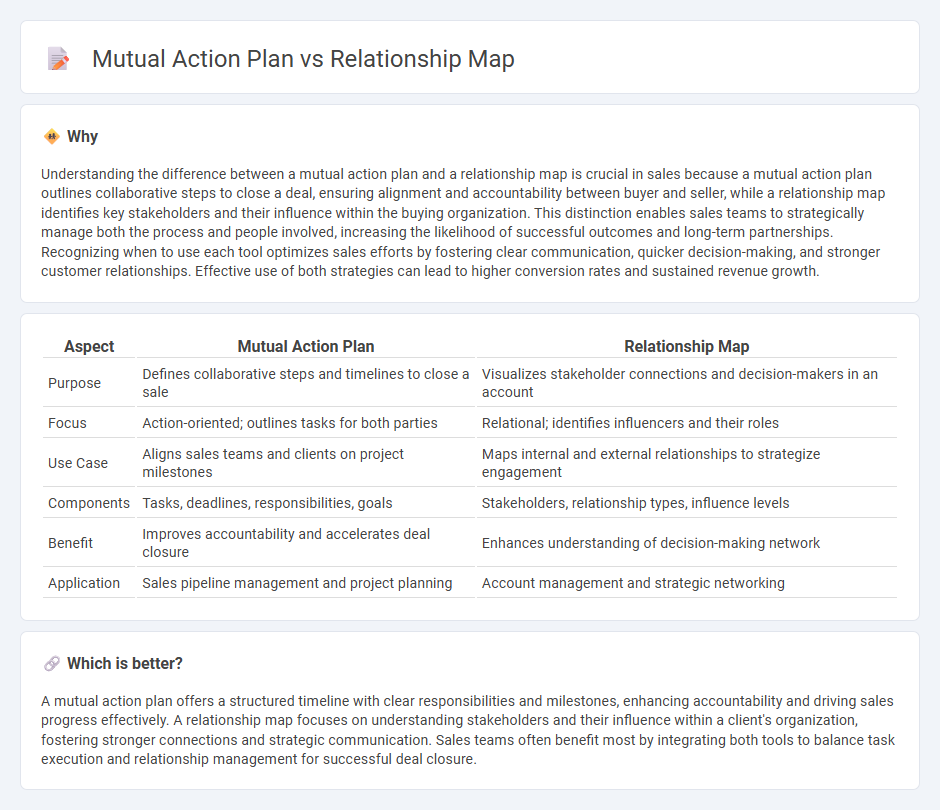
A mutual action plan outlines clear, shared milestones and responsibilities between buyer and seller to drive a sale toward closure efficiently. A relationship map identifies key stakeholders and their influence within the buyer's organization to tailor communication and strengthen engagement strategically. Explore further to understand how aligning these tools enhances sales success.
Why it is important
Understanding the difference between a mutual action plan and a relationship map is crucial in sales because a mutual action plan outlines collaborative steps to close a deal, ensuring alignment and accountability between buyer and seller, while a relationship map identifies key stakeholders and their influence within the buying organization. This distinction enables sales teams to strategically manage both the process and people involved, increasing the likelihood of successful outcomes and long-term partnerships. Recognizing when to use each tool optimizes sales efforts by fostering clear communication, quicker decision-making, and stronger customer relationships. Effective use of both strategies can lead to higher conversion rates and sustained revenue growth.
Comparison Table
| Aspect | Mutual Action Plan | Relationship Map |
|---|---|---|
| Purpose | Defines collaborative steps and timelines to close a sale | Visualizes stakeholder connections and decision-makers in an account |
| Focus | Action-oriented; outlines tasks for both parties | Relational; identifies influencers and their roles |
| Use Case | Aligns sales teams and clients on project milestones | Maps internal and external relationships to strategize engagement |
| Components | Tasks, deadlines, responsibilities, goals | Stakeholders, relationship types, influence levels |
| Benefit | Improves accountability and accelerates deal closure | Enhances understanding of decision-making network |
| Application | Sales pipeline management and project planning | Account management and strategic networking |
Which is better?
A mutual action plan offers a structured timeline with clear responsibilities and milestones, enhancing accountability and driving sales progress effectively. A relationship map focuses on understanding stakeholders and their influence within a client's organization, fostering stronger connections and strategic communication. Sales teams often benefit most by integrating both tools to balance task execution and relationship management for successful deal closure.
Connection
A mutual action plan outlines the specific steps and responsibilities both buyer and seller agree upon to achieve a successful sales outcome. The relationship map identifies key stakeholders and their roles within the buyer's organization, ensuring the mutual action plan addresses the right decision-makers. Together, they align sales strategies with organizational dynamics, increasing the likelihood of deal closure and customer satisfaction.
Key Terms
**Relationship Map:**
A Relationship Map visually represents key stakeholders, their roles, and interconnections within an organization, enhancing collaboration and strategic communication. It identifies influencers and decision-makers to streamline engagement efforts and foster stronger partnerships. Explore how leveraging a Relationship Map can improve your organizational insights and stakeholder management.
Stakeholder Analysis
Relationship maps visually represent connections and influence patterns among stakeholders, highlighting key decision-makers and communication flows. Mutual action plans establish collaborative, step-by-step commitments from stakeholders to achieve shared objectives, enhancing accountability and progress tracking. Explore how integrating both tools optimizes stakeholder analysis and drives successful project outcomes.
Decision-Maker Identification
Decision-maker identification is central to both relationship maps and mutual action plans, with relationship maps visually outlining key stakeholders and their influence within an organization, ensuring targeted engagement. Mutual action plans emphasize identifying decision-makers to align collaborative steps and timelines that drive consensus and commitment from all parties involved. Explore detailed strategies to enhance decision-maker identification and improve sales outcomes.
Source and External Links
Relationship Mapping: Strategically Focus on Key People - A relationship map is a diagram focusing on essential teams, people, and resources within an organization, starting from yourself and your boss, to visualize and cultivate key relationships effectively.
Relationship Mapping for your Key Accounts - This defines a relationship map as a visual of connections beyond formal hierarchy, highlighting informal networks and influence among individuals or groups to improve sales strategy and stakeholder engagement.
Relationship Mapping 101: What It Is and Why It Matters - Relationship mapping visually represents entities and their connections to identify key players, information flow, and optimize collaboration by analyzing nodes (entities) and edges (relationships).
 dowidth.com
dowidth.com